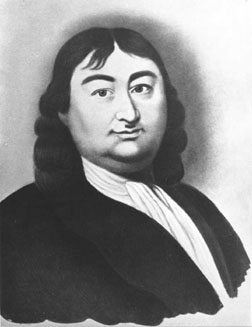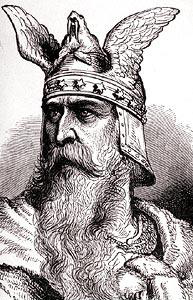
Vitus Bering
Vitus Jonassen Bering (also, less correctly, Behring) (August 12, 1681 in Horsens, Denmark – December 8, 1741, Bering Island, Russia) was a Danish navigator in the service of the Russian Navy, a captain-komandor known among the Russian sailors as Ivan Ivanovich. He is noted for being the first European to discover Alaska and its Aleutian Islands. The Bering Strait, the Bering Sea, Bering Island, Bering Glacier and the Bering Land Bridge bear the explorer's name.
Leif Ericson (Old Norse: Leifr Eiríksson)[1] (c. 970 – c. 1020) was a Norse[2] explorer who is currently regarded as the first European to land in North America (excluding Greenland), nearly five hundred years before Christopher Columbus.[3] According to the Sagas of Icelanders, he established a Norse settlement at Vinland, which has been tentatively identified with the L'Anse aux Meadows Norse site on the northern tip of the island of Newfoundland in Newfoundland and Labrador, Canada.
It is believed that Leif was born about AD 970 in Iceland, the son of Erik the Red (Old Norse: Eiríkr inn rauði), a Norse explorer from Western Norway, an outlaw and himself the son of an outlaw, Þorvaldr Ásvaldsson. Leif's mother was Thjodhild (Þjóðhildr).[4] Erik the Red founded two Norse colonies in Greenland, the Western Settlement and the Eastern Settlement, as he named them. In both Eiríks saga rauða and Landnáma, Leif's father is said to have met and married Leif's mother Þjóðhildur in Iceland; no official site is known for Leif's birth.[5]
Leif Ericson had two brothers, Thorvald and Thorsteinn, and one half sister,[citation needed] Freydís. He married a woman named Thorgunna, and they had one son, Thorkell Leifsson.
Estevanico (c. 1500 – 1539) (also known as "Mustafa Zemmouri", "Black Stephen", "Esteban", "Esteban the Moor", "Estevan", "Estebanico", "Stephen the Black", "Stephen the Moor", and "Little Stephen") was of Berber North African origin, possibly from Azemmour, Morocco. He was the first known person born in North Africa to have arrived in the present-day continental United States. An enslaved servant, he was one of four survivors of the Spanish Narváez expedition and traveled with explorer Álvar Núñez Cabeza de Vaca across the Southwest. Estevanico, Cabeza De Vaca, and Andres Dorantes were saved by a man named Alonso Del Castillo who is supposed to be the magic healer.
A Viking (pron. /ˈvaɪkɪŋ/) is one of the Norse (Scandinavian) explorers, warriors, merchants, and pirates who raided and colonized wide areas of Europe from the late eighth to the early eleventh century.[1] These Norsemen used their famed longships to travel as far east as Constantinople and the Volga River in Russia, and as far west as Iceland, Greenland, and Newfoundland. This period of Viking expansion is known as the Viking Age, and forms a major part of the medieval history of Scandinavia, Britain, Ireland and the rest of Europe in general.
A romanticized picture of Vikings as Germanic noble savages emerged in the 18th century, and expanded during the Victorian era Viking revival.[2] In Britain it took the form of Septentrionalism, in Germany that of "Wagnerian" pathos or even Germanic mysticism, and in the Scandinavian countries that of Romantic nationalism or Scandinavism. In contemporary popular culture these clichéd depictions are often exaggerated with the effect of presenting Vikings as caricatures.

No comments:
Post a Comment